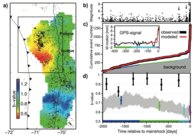(b) Statistical Seismology
Because of the complexity of the earthquake processes and observations, there is a clear need in earthquake physics for more integrative observations, modelling, and analyses. By means of statistical approaches, we study the earthquake distributions in space, time, and magnitude of recorded seismicity data on local, regional and global scale. In particular, we focus on human-induced seismicity and natural earthquake clusters as foreshock activity (see Figure related to the 2014 M8.1 Iquique main shock in Chile), aftershocks and earthquake swarms, and the recurrence of major events on fault systems. We estimate earthquake rates, test hypotheses, and formulate seismicity models. We use purely data-driven statistical models such as the Epidemic Aftershock-Type Sequence (ETAS) model as well as statistical models based on observed deformation data, Coulomb stress calculations, and rate- and state-dependent friction. The seismicity models are calibrated by data assimilation and used for time-dependent earthquake forecasts and seismic hazard assessment.
Involved scientists from Sec. 2.1:
Simone Cesca
Torsten Dahm
Sebastian Hainzl
Daniela Kühn
Shubham Sharma, PhD
Behnam Maleki Asayesh
The work is done in cooperation with Section 2.6 (Danijel Schorlemmer) and Institute of Mathematics at the University of Potsdam(Gert Zöller, Matthias Holschneider) durchgeführt.



